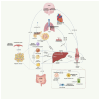RNAkines are secreted messengers shaping health and disease
- PMID: 38160178
- PMCID: PMC7617407
- DOI: 10.1016/j.tem.2023.12.004
RNAkines are secreted messengers shaping health and disease
Abstract
Extracellular noncoding RNAs (ncRNAs) have crucial roles in intercellular communications. The process of ncRNA secretion is highly regulated, with specific ncRNA profiles produced under different physiological and pathological circumstances. These ncRNAs are transported primarily via extracellular vesicles (EVs) from their origin cells to target cells, utilising both endocrine and paracrine pathways. The intercellular impacts of extracellular ncRNAs are essential for maintaining homeostasis and the pathogenesis of various diseases. Given the unique aspects of extracellular ncRNAs, here we propose the term 'RNAkine' to describe these recently identified secreted factors. We explore their roles as intercellular modulators, particularly in their ability to regulate metabolism and influence tumorigenesis, highlighting their definition and importance as a distinct class of secreted factors.
Keywords: RNAkine; cancer; extracellular noncoding RNA; metabolism.
Copyright © 2023 The Authors. Published by Elsevier Ltd.. All rights reserved.
Conflict of interest statement
Declaration of interests The authors declare no competing interests.
Figures



Similar articles
-
Extracellular vesicles-mediated noncoding RNAs transfer in cancer.J Hematol Oncol. 2017 Feb 23;10(1):57. doi: 10.1186/s13045-017-0426-y. J Hematol Oncol. 2017. PMID: 28231804 Free PMC article. Review.
-
EV-mediated intercellular communication in acute myeloid leukemia: Transport of genetic materials in the bone marrow microenvironment.Exp Hematol. 2024 May;133:104175. doi: 10.1016/j.exphem.2024.104175. Epub 2024 Feb 2. Exp Hematol. 2024. PMID: 38311165 Review.
-
The Role of Extracellular Vesicles as Shuttles of RNA and Their Clinical Significance as Biomarkers in Hepatocellular Carcinoma.Genes (Basel). 2021 Jun 11;12(6):902. doi: 10.3390/genes12060902. Genes (Basel). 2021. PMID: 34207985 Free PMC article. Review.
-
Biological Characteristics and Roles of Noncoding RNAs in Milk-Derived Extracellular Vesicles.Adv Nutr. 2021 Jun 1;12(3):1006-1019. doi: 10.1093/advances/nmaa124. Adv Nutr. 2021. PMID: 33080010 Free PMC article. Review.
-
Focus on Extracellular Vesicles: Physiological Role and Signalling Properties of Extracellular Membrane Vesicles.Int J Mol Sci. 2016 Feb 6;17(2):171. doi: 10.3390/ijms17020171. Int J Mol Sci. 2016. PMID: 26861302 Free PMC article. Review.
Cited by
-
An adipocentric perspective of pancreatic lipotoxicity in diabetes pathogenesis.J Endocrinol. 2024 May 15;262(1):e230313. doi: 10.1530/JOE-23-0313. Print 2024 Jul 1. J Endocrinol. 2024. PMID: 38642584 Free PMC article. Review.
-
Myokines: metabolic regulation in obesity and type 2 diabetes.Life Metab. 2024 Mar 2;3(3):loae006. doi: 10.1093/lifemeta/loae006. eCollection 2024 Jun. Life Metab. 2024. PMID: 39872377 Free PMC article. Review.
-
Inter-organ communication is a critical machinery to regulate metabolism and aging.Trends Endocrinol Metab. 2025 Aug;36(8):756-766. doi: 10.1016/j.tem.2024.11.013. Epub 2024 Dec 17. Trends Endocrinol Metab. 2025. PMID: 39694728 Free PMC article. Review.
-
Development and validation of prognostic models based on cell cycle-related signatures for predicting the prognosis of patients with lung adenocarcinoma.Transl Cancer Res. 2025 May 30;14(5):2900-2915. doi: 10.21037/tcr-24-1479. Epub 2025 May 27. Transl Cancer Res. 2025. PMID: 40530147 Free PMC article.
-
Characterization and analysis of extracellular vesicle-derived miRNAs from different adipose tissues in mice.Heliyon. 2024 Oct 9;10(20):e39149. doi: 10.1016/j.heliyon.2024.e39149. eCollection 2024 Oct 30. Heliyon. 2024. PMID: 39640764 Free PMC article.
References
-
- Valadi H, et al. Exosome-mediated transfer of mRNAs and microRNAs is a novel mechanism of genetic exchange between cells. Nat Cell Biol. 2007;9:654–659. - PubMed
-
- Chen X, et al. Characterization of microRNAs in serum: a novel class of biomarkers for diagnosis of cancer and other diseases. Cell Res. 2008;18:997–1006. - PubMed
-
- Lawrie CH, et al. Detection of elevated levels of tumour-associated microRNAs in serum of patients with diffuse large B-cell lymphoma. Brit J Haematol. 2008;141:672–675. - PubMed
Publication types
MeSH terms
Substances
Grants and funding
LinkOut - more resources
Full Text Sources

